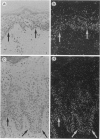Abstract
One of the biological characteristics of psoriasis is excessive flaking of the skin. This is directly related to the marked hyperplasia of epidermal keratinocytes and to incomplete epidermal differentiation. Keratinocyte growth factor (KGF), a potent mitogen for human keratinocytes, is expressed by stromal cells. Alterations in the KGF signaling pathway might account for the epidermal hyperplasia associated with psoriasis. To test this hypothesis, we investigated the expression of KGF and its receptor (KGFR) in psoriasis tissue. KGF and KGFR mRNA levels were found to be frequently elevated in psoriatic skin specimens as compared with normal skin. Increased KGF transcript expression was localized to the dermal layer of the involved skin specimen using in situ hybridization. In contrast, KGFR transcript and protein expression was localized to the basal layer of keratinocytes in normal skin and to the basal and suprabasal layers of the psoriatic epidermis, coincident with the expanded proliferative keratinocyte pool. To identify molecules that might regulate KGFR expression we investigated the effects of various pharmacological agents and cytokines on KGFR synthesis by keratinocytes. Phorbol ester, interleukin-6, interferon-gamma, and ultraviolet B (UVB) treatment all led to substantial down-regulation of KGFR expression. The down-regulation of KGFR synthesis by UVB suggests a possible mechanism for the antiproliferative action of this agent in the treatment of psoriasis. Taken together, these results suggest that increased KGFR-mediated signaling in keratinocytes in the lesional epidermis might account in part for the epidermal hyperplasia in psoriasis.
Full text
PDF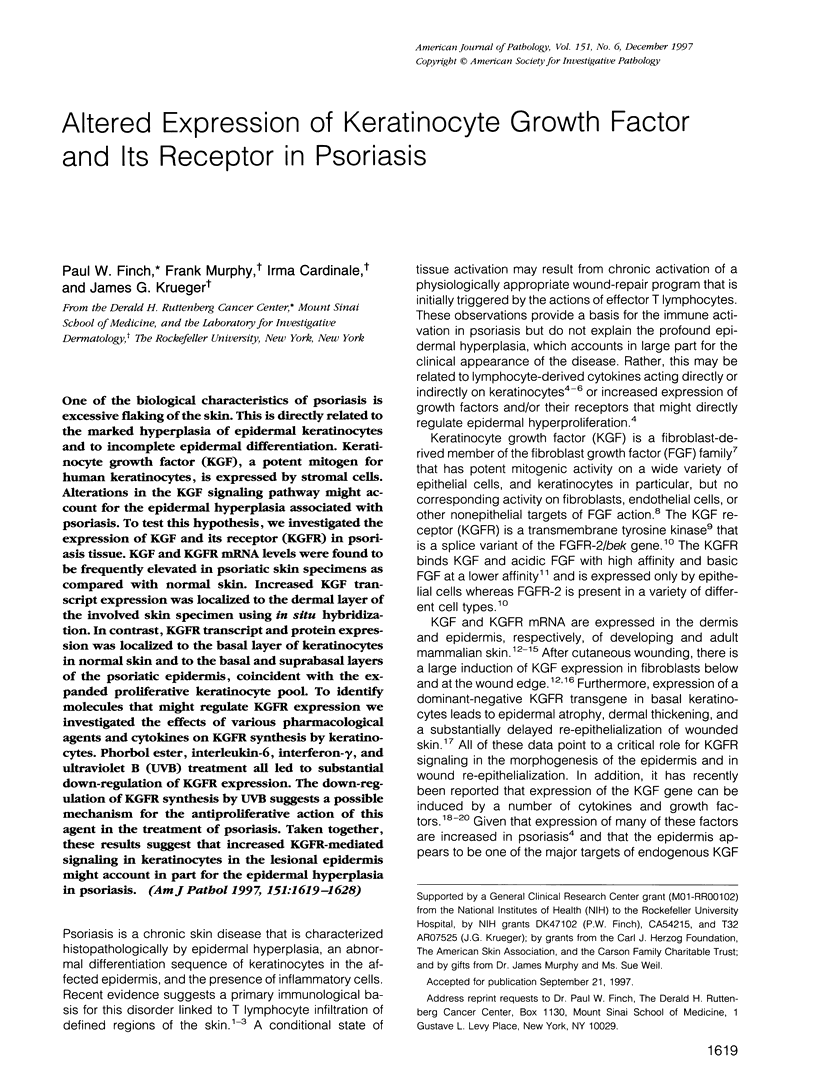
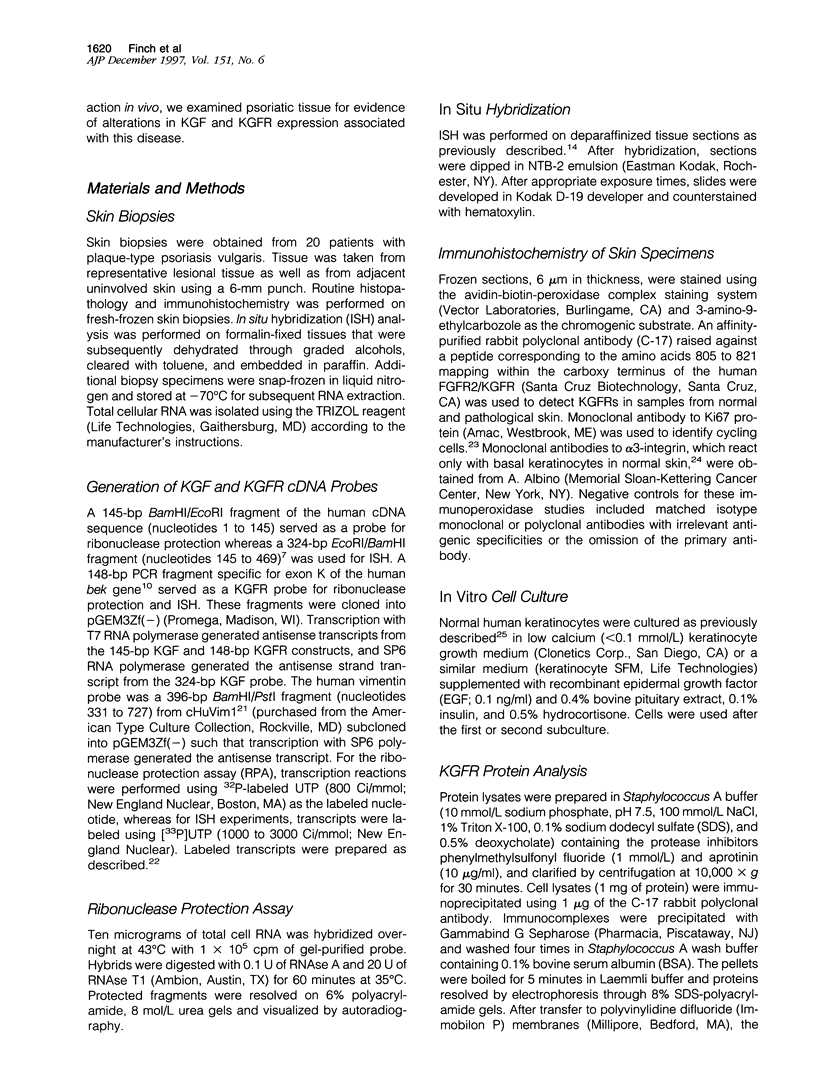
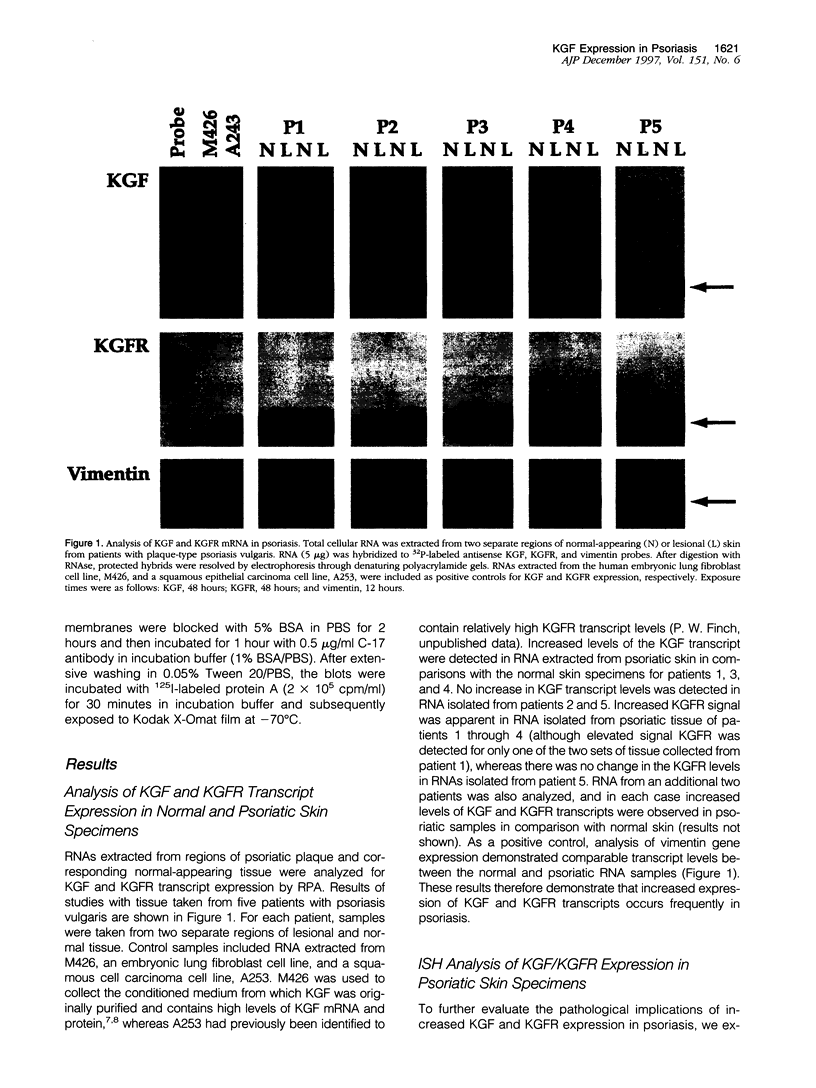
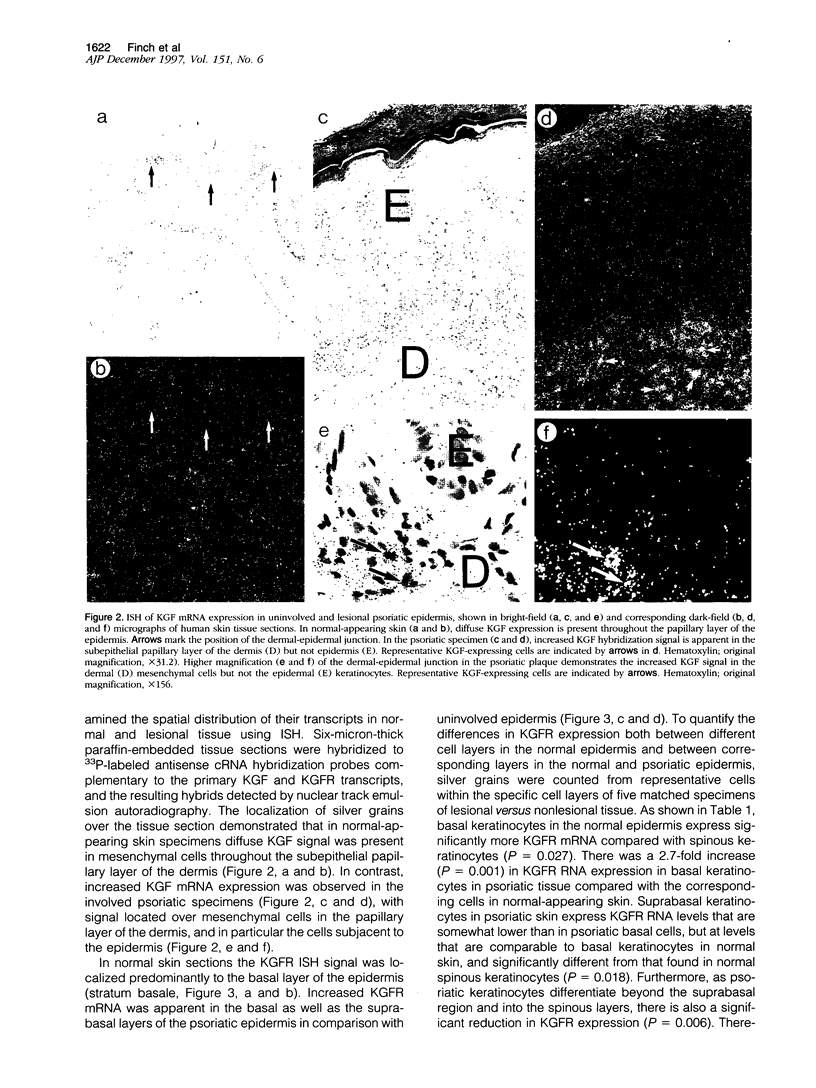
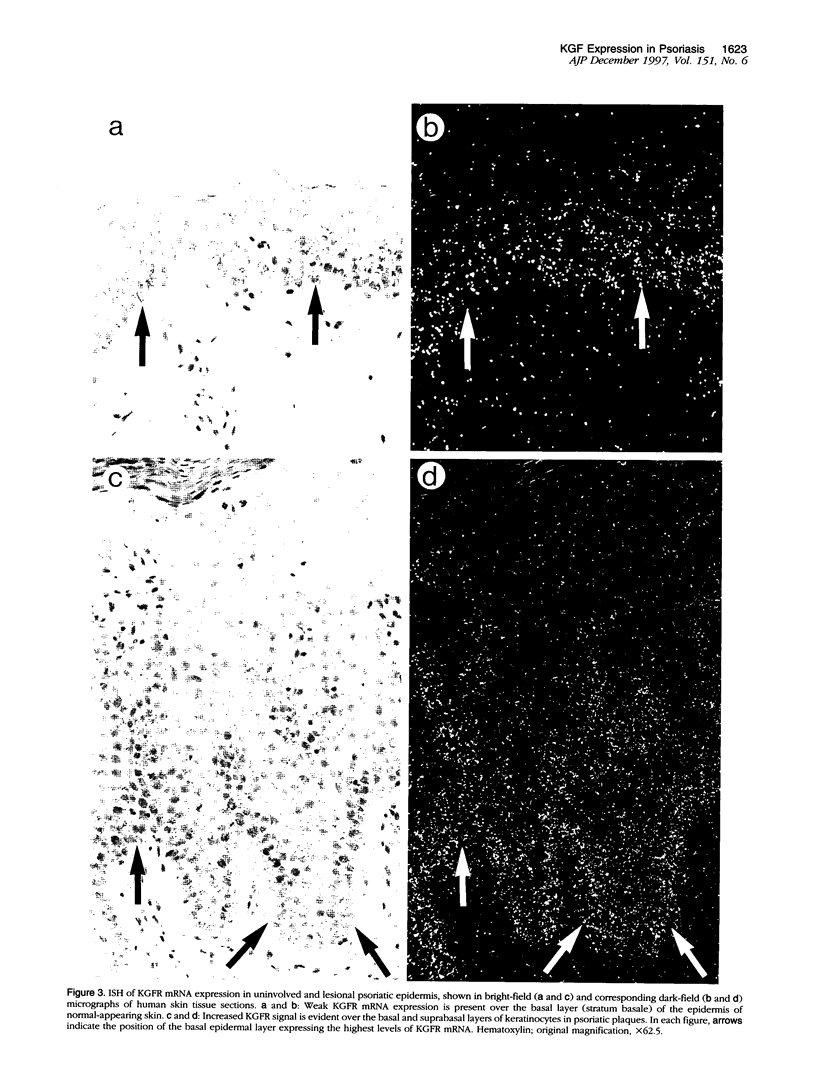
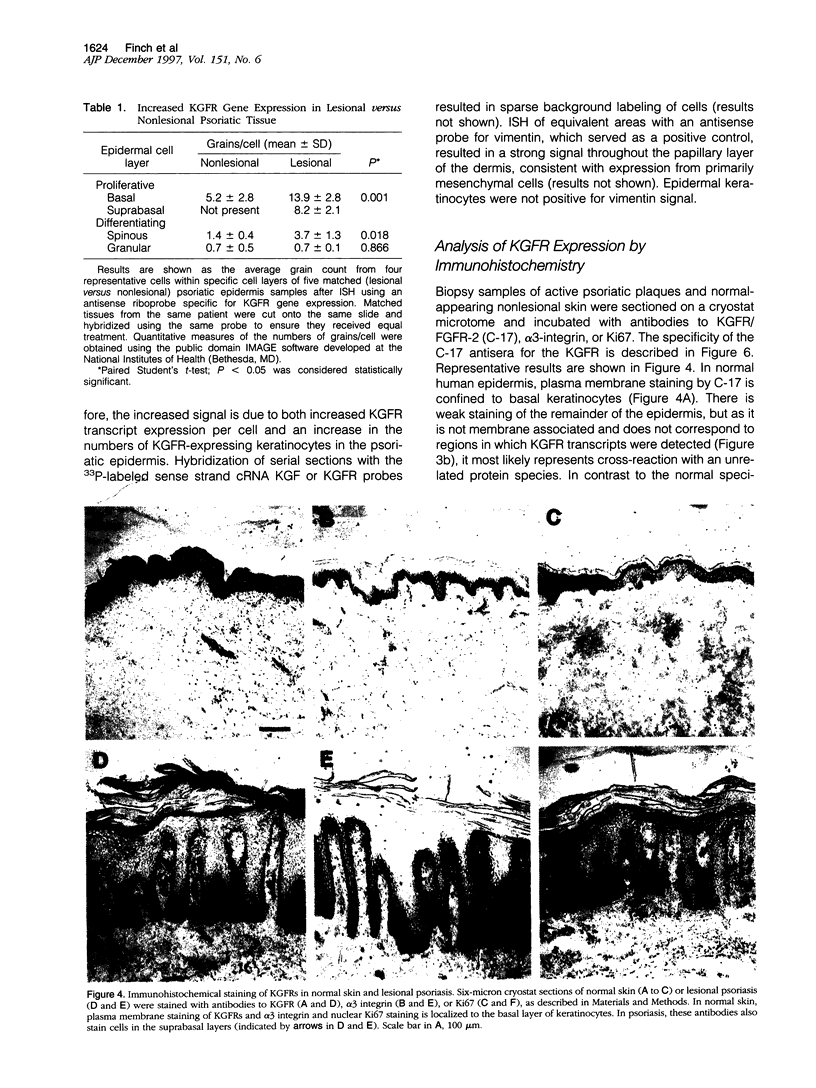
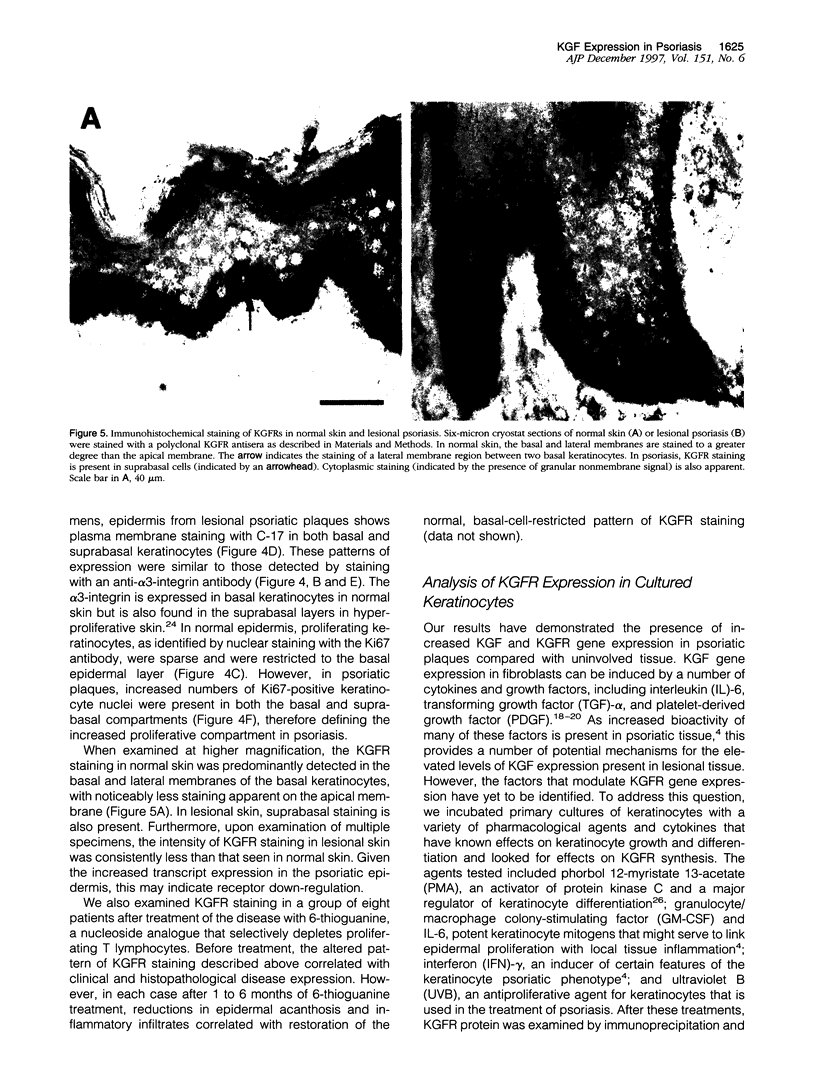
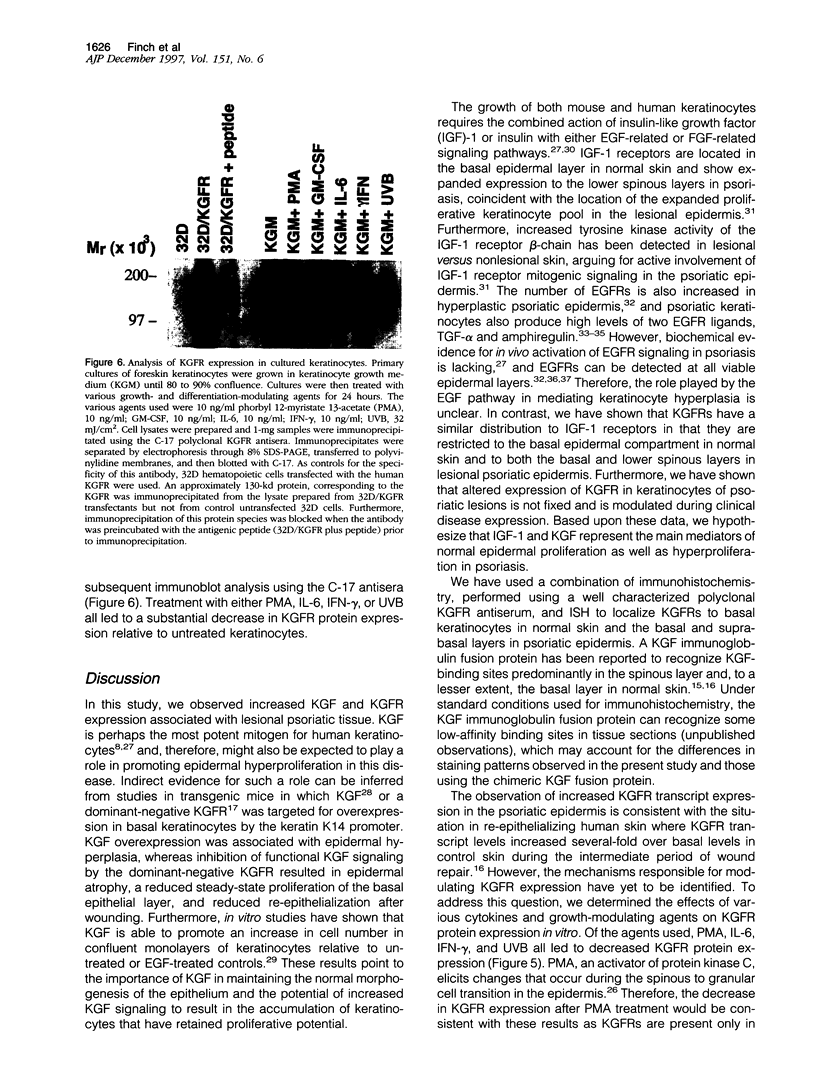
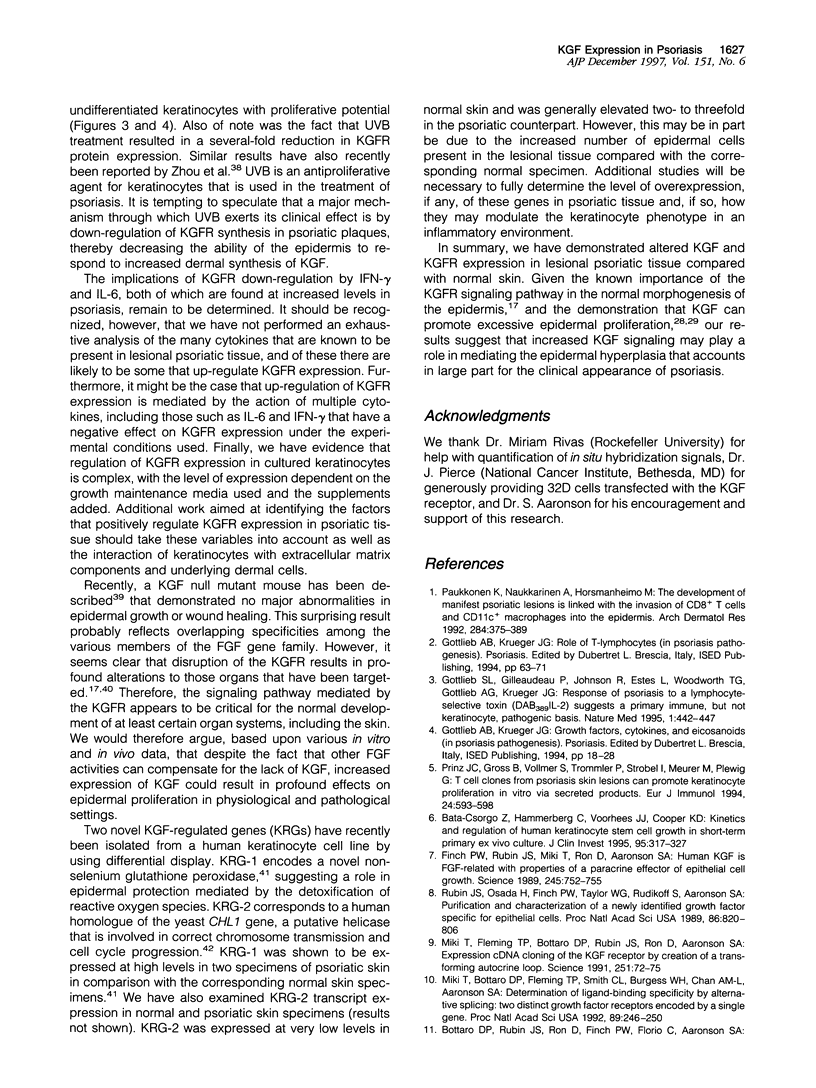
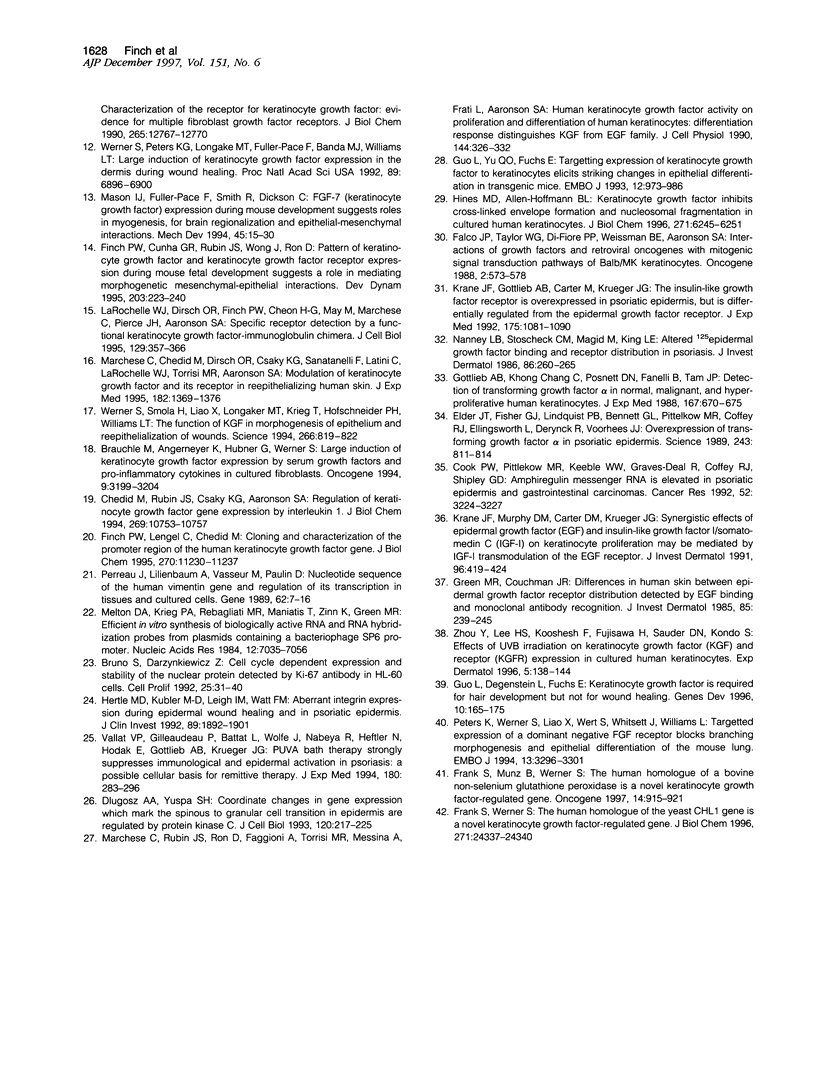
Images in this article
Selected References
These references are in PubMed. This may not be the complete list of references from this article.
- Bata-Csorgo Z., Hammerberg C., Voorhees J. J., Cooper K. D. Kinetics and regulation of human keratinocyte stem cell growth in short-term primary ex vivo culture. Cooperative growth factors from psoriatic lesional T lymphocytes stimulate proliferation among psoriatic uninvolved, but not normal, stem keratinocytes. J Clin Invest. 1995 Jan;95(1):317–327. doi: 10.1172/JCI117659. [DOI] [PMC free article] [PubMed] [Google Scholar]
- Brauchle M., Angermeyer K., Hübner G., Werner S. Large induction of keratinocyte growth factor expression by serum growth factors and pro-inflammatory cytokines in cultured fibroblasts. Oncogene. 1994 Nov;9(11):3199–3204. [PubMed] [Google Scholar]
- Bruno S., Darzynkiewicz Z. Cell cycle dependent expression and stability of the nuclear protein detected by Ki-67 antibody in HL-60 cells. Cell Prolif. 1992 Jan;25(1):31–40. doi: 10.1111/j.1365-2184.1992.tb01435.x. [DOI] [PubMed] [Google Scholar]
- Chedid M., Rubin J. S., Csaky K. G., Aaronson S. A. Regulation of keratinocyte growth factor gene expression by interleukin 1. J Biol Chem. 1994 Apr 8;269(14):10753–10757. [PubMed] [Google Scholar]
- Cook P. W., Pittelkow M. R., Keeble W. W., Graves-Deal R., Coffey R. J., Jr, Shipley G. D. Amphiregulin messenger RNA is elevated in psoriatic epidermis and gastrointestinal carcinomas. Cancer Res. 1992 Jun 1;52(11):3224–3227. [PubMed] [Google Scholar]
- Dlugosz A. A., Yuspa S. H. Coordinate changes in gene expression which mark the spinous to granular cell transition in epidermis are regulated by protein kinase C. J Cell Biol. 1993 Jan;120(1):217–225. doi: 10.1083/jcb.120.1.217. [DOI] [PMC free article] [PubMed] [Google Scholar]
- Elder J. T., Fisher G. J., Lindquist P. B., Bennett G. L., Pittelkow M. R., Coffey R. J., Jr, Ellingsworth L., Derynck R., Voorhees J. J. Overexpression of transforming growth factor alpha in psoriatic epidermis. Science. 1989 Feb 10;243(4892):811–814. doi: 10.1126/science.2916128. [DOI] [PubMed] [Google Scholar]
- Falco J. P., Taylor W. G., Di Fiore P. P., Weissman B. E., Aaronson S. A. Interactions of growth factors and retroviral oncogenes with mitogenic signal transduction pathways of Balb/MK keratinocytes. Oncogene. 1988 Jun;2(6):573–578. [PubMed] [Google Scholar]
- Finch P. W., Cunha G. R., Rubin J. S., Wong J., Ron D. Pattern of keratinocyte growth factor and keratinocyte growth factor receptor expression during mouse fetal development suggests a role in mediating morphogenetic mesenchymal-epithelial interactions. Dev Dyn. 1995 Jun;203(2):223–240. doi: 10.1002/aja.1002030210. [DOI] [PubMed] [Google Scholar]
- Finch P. W., Lengel C., Chedid M. Cloning and characterization of the promoter region of the human keratinocyte growth factor gene. J Biol Chem. 1995 May 12;270(19):11230–11237. doi: 10.1074/jbc.270.19.11230. [DOI] [PubMed] [Google Scholar]
- Finch P. W., Rubin J. S., Miki T., Ron D., Aaronson S. A. Human KGF is FGF-related with properties of a paracrine effector of epithelial cell growth. Science. 1989 Aug 18;245(4919):752–755. doi: 10.1126/science.2475908. [DOI] [PubMed] [Google Scholar]
- Frank S., Munz B., Werner S. The human homologue of a bovine non-selenium glutathione peroxidase is a novel keratinocyte growth factor-regulated gene. Oncogene. 1997 Feb 27;14(8):915–921. doi: 10.1038/sj.onc.1200905. [DOI] [PubMed] [Google Scholar]
- Frank S., Werner S. The human homologue of the yeast CHL1 gene is a novel keratinocyte growth factor-regulated gene. J Biol Chem. 1996 Oct 4;271(40):24337–24340. doi: 10.1074/jbc.271.40.24337. [DOI] [PubMed] [Google Scholar]
- Gottlieb A. B., Chang C. K., Posnett D. N., Fanelli B., Tam J. P. Detection of transforming growth factor alpha in normal, malignant, and hyperproliferative human keratinocytes. J Exp Med. 1988 Feb 1;167(2):670–675. doi: 10.1084/jem.167.2.670. [DOI] [PMC free article] [PubMed] [Google Scholar]
- Gottlieb S. L., Gilleaudeau P., Johnson R., Estes L., Woodworth T. G., Gottlieb A. B., Krueger J. G. Response of psoriasis to a lymphocyte-selective toxin (DAB389IL-2) suggests a primary immune, but not keratinocyte, pathogenic basis. Nat Med. 1995 May;1(5):442–447. doi: 10.1038/nm0595-442. [DOI] [PubMed] [Google Scholar]
- Green M. R., Couchman J. R. Differences in human skin between the epidermal growth factor receptor distribution detected by EGF binding and monoclonal antibody recognition. J Invest Dermatol. 1985 Sep;85(3):239–245. doi: 10.1111/1523-1747.ep12276708. [DOI] [PubMed] [Google Scholar]
- Guo L., Degenstein L., Fuchs E. Keratinocyte growth factor is required for hair development but not for wound healing. Genes Dev. 1996 Jan 15;10(2):165–175. doi: 10.1101/gad.10.2.165. [DOI] [PubMed] [Google Scholar]
- Guo L., Yu Q. C., Fuchs E. Targeting expression of keratinocyte growth factor to keratinocytes elicits striking changes in epithelial differentiation in transgenic mice. EMBO J. 1993 Mar;12(3):973–986. doi: 10.1002/j.1460-2075.1993.tb05738.x. [DOI] [PMC free article] [PubMed] [Google Scholar]
- Hertle M. D., Kubler M. D., Leigh I. M., Watt F. M. Aberrant integrin expression during epidermal wound healing and in psoriatic epidermis. J Clin Invest. 1992 Jun;89(6):1892–1901. doi: 10.1172/JCI115794. [DOI] [PMC free article] [PubMed] [Google Scholar]
- Hines M. D., Allen-Hoffmann B. L. Keratinocyte growth factor inhibits cross-linked envelope formation and nucleosomal fragmentation in cultured human keratinocytes. J Biol Chem. 1996 Mar 15;271(11):6245–6251. doi: 10.1074/jbc.271.11.6245. [DOI] [PubMed] [Google Scholar]
- Krane J. F., Gottlieb A. B., Carter D. M., Krueger J. G. The insulin-like growth factor I receptor is overexpressed in psoriatic epidermis, but is differentially regulated from the epidermal growth factor receptor. J Exp Med. 1992 Apr 1;175(4):1081–1090. doi: 10.1084/jem.175.4.1081. [DOI] [PMC free article] [PubMed] [Google Scholar]
- Krane J. F., Murphy D. P., Carter D. M., Krueger J. G. Synergistic effects of epidermal growth factor (EGF) and insulin-like growth factor I/somatomedin C (IGF-I) on keratinocyte proliferation may be mediated by IGF-I transmodulation of the EGF receptor. J Invest Dermatol. 1991 Apr;96(4):419–424. doi: 10.1111/1523-1747.ep12469799. [DOI] [PubMed] [Google Scholar]
- LaRochelle W. J., Dirsch O. R., Finch P. W., Cheon H. G., May M., Marchese C., Pierce J. H., Aaronson S. A. Specific receptor detection by a functional keratinocyte growth factor-immunoglobulin chimera. J Cell Biol. 1995 Apr;129(2):357–366. doi: 10.1083/jcb.129.2.357. [DOI] [PMC free article] [PubMed] [Google Scholar]
- Marchese C., Chedid M., Dirsch O. R., Csaky K. G., Santanelli F., Latini C., LaRochelle W. J., Torrisi M. R., Aaronson S. A. Modulation of keratinocyte growth factor and its receptor in reepithelializing human skin. J Exp Med. 1995 Nov 1;182(5):1369–1376. doi: 10.1084/jem.182.5.1369. [DOI] [PMC free article] [PubMed] [Google Scholar]
- Marchese C., Rubin J., Ron D., Faggioni A., Torrisi M. R., Messina A., Frati L., Aaronson S. A. Human keratinocyte growth factor activity on proliferation and differentiation of human keratinocytes: differentiation response distinguishes KGF from EGF family. J Cell Physiol. 1990 Aug;144(2):326–332. doi: 10.1002/jcp.1041440219. [DOI] [PubMed] [Google Scholar]
- Mason I. J., Fuller-Pace F., Smith R., Dickson C. FGF-7 (keratinocyte growth factor) expression during mouse development suggests roles in myogenesis, forebrain regionalisation and epithelial-mesenchymal interactions. Mech Dev. 1994 Jan;45(1):15–30. doi: 10.1016/0925-4773(94)90050-7. [DOI] [PubMed] [Google Scholar]
- Melton D. A., Krieg P. A., Rebagliati M. R., Maniatis T., Zinn K., Green M. R. Efficient in vitro synthesis of biologically active RNA and RNA hybridization probes from plasmids containing a bacteriophage SP6 promoter. Nucleic Acids Res. 1984 Sep 25;12(18):7035–7056. doi: 10.1093/nar/12.18.7035. [DOI] [PMC free article] [PubMed] [Google Scholar]
- Miki T., Bottaro D. P., Fleming T. P., Smith C. L., Burgess W. H., Chan A. M., Aaronson S. A. Determination of ligand-binding specificity by alternative splicing: two distinct growth factor receptors encoded by a single gene. Proc Natl Acad Sci U S A. 1992 Jan 1;89(1):246–250. doi: 10.1073/pnas.89.1.246. [DOI] [PMC free article] [PubMed] [Google Scholar]
- Miki T., Fleming T. P., Bottaro D. P., Rubin J. S., Ron D., Aaronson S. A. Expression cDNA cloning of the KGF receptor by creation of a transforming autocrine loop. Science. 1991 Jan 4;251(4989):72–75. doi: 10.1126/science.1846048. [DOI] [PubMed] [Google Scholar]
- Nanney L. B., Stoscheck C. M., Magid M., King L. E., Jr Altered [125I]epidermal growth factor binding and receptor distribution in psoriasis. J Invest Dermatol. 1986 Mar;86(3):260–265. doi: 10.1111/1523-1747.ep12285389. [DOI] [PubMed] [Google Scholar]
- Paukkonen K., Naukkarinen A., Horsmanheimo M. The development of manifest psoriatic lesions is linked with the invasion of CD8 + T cells and CD11c + macrophages into the epidermis. Arch Dermatol Res. 1992;284(7):375–379. doi: 10.1007/BF00372065. [DOI] [PubMed] [Google Scholar]
- Perreau J., Lilienbaum A., Vasseur M., Paulin D. Nucleotide sequence of the human vimentin gene and regulation of its transcription in tissues and cultured cells. Gene. 1988;62(1):7–16. doi: 10.1016/0378-1119(88)90575-6. [DOI] [PubMed] [Google Scholar]
- Peters K., Werner S., Liao X., Wert S., Whitsett J., Williams L. Targeted expression of a dominant negative FGF receptor blocks branching morphogenesis and epithelial differentiation of the mouse lung. EMBO J. 1994 Jul 15;13(14):3296–3301. doi: 10.1002/j.1460-2075.1994.tb06631.x. [DOI] [PMC free article] [PubMed] [Google Scholar]
- Prinz J. C., Gross B., Vollmer S., Trommler P., Strobel I., Meurer M., Plewig G. T cell clones from psoriasis skin lesions can promote keratinocyte proliferation in vitro via secreted products. Eur J Immunol. 1994 Mar;24(3):593–598. doi: 10.1002/eji.1830240315. [DOI] [PubMed] [Google Scholar]
- Rubin J. S., Osada H., Finch P. W., Taylor W. G., Rudikoff S., Aaronson S. A. Purification and characterization of a newly identified growth factor specific for epithelial cells. Proc Natl Acad Sci U S A. 1989 Feb;86(3):802–806. doi: 10.1073/pnas.86.3.802. [DOI] [PMC free article] [PubMed] [Google Scholar]
- Vallat V. P., Gilleaudeau P., Battat L., Wolfe J., Nabeya R., Heftler N., Hodak E., Gottlieb A. B., Krueger J. G. PUVA bath therapy strongly suppresses immunological and epidermal activation in psoriasis: a possible cellular basis for remittive therapy. J Exp Med. 1994 Jul 1;180(1):283–296. doi: 10.1084/jem.180.1.283. [DOI] [PMC free article] [PubMed] [Google Scholar]
- Werner S., Peters K. G., Longaker M. T., Fuller-Pace F., Banda M. J., Williams L. T. Large induction of keratinocyte growth factor expression in the dermis during wound healing. Proc Natl Acad Sci U S A. 1992 Aug 1;89(15):6896–6900. doi: 10.1073/pnas.89.15.6896. [DOI] [PMC free article] [PubMed] [Google Scholar]
- Werner S., Smola H., Liao X., Longaker M. T., Krieg T., Hofschneider P. H., Williams L. T. The function of KGF in morphogenesis of epithelium and reepithelialization of wounds. Science. 1994 Nov 4;266(5186):819–822. doi: 10.1126/science.7973639. [DOI] [PubMed] [Google Scholar]
- Zhou Y., Lee H. S., Kooshesh F., Fujisawa H., Sauder D. N., Kondo S. Effects of UVB irradiation on keratinocyte growth factor (KGF) and receptor (KGFR) expression in cultured human keratinocytes. Exp Dermatol. 1996 Jun;5(3):138–144. doi: 10.1111/j.1600-0625.1996.tb00108.x. [DOI] [PubMed] [Google Scholar]





